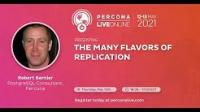Here’s a breakdown of the topics that will be covered:
– We start with the replication configurations and which includes:
– multi node PRIMARY-STANDBY replication cluster
– Cascading Replication
– Other:
– Replicating to another READ-WRITE host
– active-active
– analytics
– Replicating to a READ-ONLY host using a time delay
– Working with detached READ-ONLY systems
– There are three (3) forms of replicating technologies that have been developed for database systems:
– statement replication
– trigger replication
– binary (the most commonly used solution)
– There are two types, or classifications, of replication which is used by Postgres:
– asynchronous replication
– synchronous replication
Of course this is by no means a complete list as there are so many methods and their variations which are possible in Postgres.
Speaker: Robert Bernier – Percona
